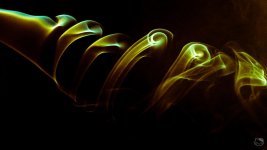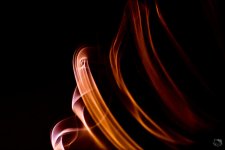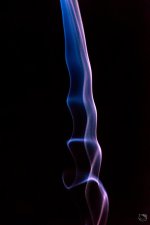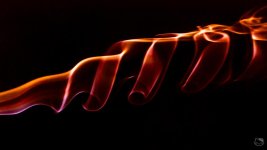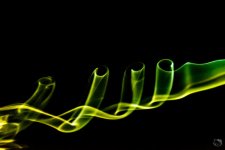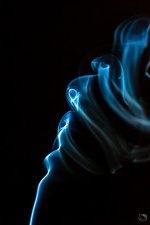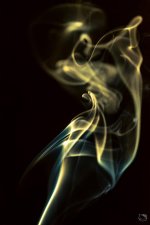You are using an out of date browser. It may not display this or other websites correctly.
You should upgrade or use an alternative browser.
You should upgrade or use an alternative browser.
Smoke and light
- Thread starter J-see
- Start date
Nice shots so far.
Experimenting is definitely the way to learn.
I do not understand your aversion to flash though. It is not cheating, or easier.
It is simply the right tool for the job. Plain and simple, some shots require the amount of light that flash provides.
It's not about cheating, I just intensely dislike the light of flash. Not using it but being subjected to it. Even if I'm at the other side of the cam, I cringe when the flash goes off. It's one of those things.
I can not see where a telephoto lens will help in any way.
My 200mm is a macro too which gives me quite a range when using it. The other advantage is a narrow field of view compared to the 35mm. With it I don't need to use a billboard sized backdrop.
PatrickDeBie
Senior Member
Boosting the ISO doesn't lead to less sharp shots. It introduces noise. And you don't want to remove noise afterwards if you can shoot pictures without any noise by using a flash and a low ISO.
My 200mm is a macro too which gives me quite a range when using it. The other advantage is a narrow field of view compared to the 35mm. With it I don't need to use a billboard sized backdrop.
I used a large black towel as a background. No need for expensive equipment.
Boosting the ISO doesn't lead to less sharp shots. It introduces noise. And you don't want to remove noise afterwards if you can shoot pictures without any noise by using a flash and a low ISO.
I used a large black towel as a background. No need for expensive equipment.
Yes high ISO introduces noise but noise isn't always terrible or restricting. When shooting high ISO the trick is to overexpose. I'm working on that now with these shots. When overexposed, much noise disappears when normalizing exposure and the rest can be corrected, if needed, by using masks or sharpen/blur locally. Those last shots are at 6400 and aren't that much noisier when processed than the 640 or 200 I did before.
I have been pushing ISO down for long under the assumption more ISO = bad. It can be but not necessarily. It's amazing what the latest cams and software can do.
I tried using a blanket but I have dogs and got pretty tired of removing backdrop hair in post.
PatrickDeBie
Senior Member
Yes high ISO introduces noise but noise isn't always terrible or restricting.
Noise can complement a picture indeed, but not with this type of photography I think. You want a clean black background and just some nice smoke patterns. Noise decreases the quality of the picture in my opinion.
When shooting high ISO the trick is to overexpose. I'm working on that now with these shots. When overexposed, much noise disappears when normalizing exposure and the rest can be corrected, if needed, by using masks or sharpen/blur locally. Those last shots are at 6400 and aren't that much noisier when processed than the 640 or 200 I did before.
I have been pushing ISO down for long under the assumption more ISO = bad. It can be but not necessarily. It's amazing what the latest cams and software can do.
So you rather post-process your image in stead of taking a good picture?
I'm not being a jerk here, I'm just confused about the fact that you don't want to use the right tools for the job without any well-founded methods which you can get the same results with.
It's like a carpenter who says he likes to use a saw for getting the nails into the wooden structure, instead of a normal hammer just to 'break the rules'.
I tried using a blanket but I have dogs and got pretty tired of removing backdrop hair in post.
You could buy a new black blanket and put it away from the dogs
There can be too much noise in these shots but I'm not shooting for a scientific study. I care about shapes and light and it needs to be sharp at the right places. I need to work at that.
That post-processing is the opposite of taking a good picture is a silly argument. Then working at shots in the darkroom was the opposite of taking a good picture too. Actually setting anything but aperture, shutter and ISO is pre-processing. Is timing what makes the difference between doing it correct and wrong?
It has little to do with taking a good shot. What I quickly discovered when going digital is that the cam, regardless of all the new technology, is still as dumb as during the analog days. It just captures light but has no idea what to do with it. It's crunching numbers. Taking a good shot is of little relevance when you can't turn those numbers into a good shot. That's where post comes in. Sure we can set the exposure correct, frame it according the rules and push the trigger and maybe what comes out is nice. But often it isn't because there are too many situations the cam is just crunching its numbers and poops out a crappy representation of that. High contrast shots as an example.
That's when you use the settings at your disposal in order to get out what you tried to shoot. If that's pushing ISO and overexposing, so be it.
That post-processing is the opposite of taking a good picture is a silly argument. Then working at shots in the darkroom was the opposite of taking a good picture too. Actually setting anything but aperture, shutter and ISO is pre-processing. Is timing what makes the difference between doing it correct and wrong?
It has little to do with taking a good shot. What I quickly discovered when going digital is that the cam, regardless of all the new technology, is still as dumb as during the analog days. It just captures light but has no idea what to do with it. It's crunching numbers. Taking a good shot is of little relevance when you can't turn those numbers into a good shot. That's where post comes in. Sure we can set the exposure correct, frame it according the rules and push the trigger and maybe what comes out is nice. But often it isn't because there are too many situations the cam is just crunching its numbers and poops out a crappy representation of that. High contrast shots as an example.
That's when you use the settings at your disposal in order to get out what you tried to shoot. If that's pushing ISO and overexposing, so be it.
Last edited:
sonicbuffalo_RIP
Senior Member
pretty cool pictures [MENTION=31330]J-see[/MENTION]
I'm not being a jerk here, I'm just confused about the fact that you don't want to use the right tools for the job without any well-founded methods which you can get the same results with.
It's like a carpenter who says he likes to use a saw for getting the nails into the wooden structure, instead of a normal hammer just to 'break the rules'.
Curious,since you seem so hung up on using a flash... Since J-See is using LED lighting from below to get various colors into the smoke, how do you think a flash is going to effect that? Wouldn't that LESSEN the effect of the colored LEDs, thus destroying his sense of what the intended capture is? Wouldn't that "whitewash" blast of light deaden the nice oranges and reds and blues?
I think J-See understands why you're suggesting flash. Heck, I'm just a backwards redneck from Oklahoma, and after the multiple statements of "use flash, use flash, use flash", even I understand why you're suggesting flash. Well, at least I understand that you think it's the only way...
Some painters use acrylics, some use oil paints, some even used "childish" watercolors. All paintings are works of art though, and have the potential to be "MORE". In the same way, some photographers, use flash, some don't, some crank the ISO. When done well, especially in light of the technology available today, nobody can tell the difference unless it's intended. Heck, many of the cameras today can shoot higher ISO with little to ZERO noise already when the shot is properly exposed. An artist, in his minds eye, knows what he's after, and given time, he'll usually get it to come out in an amazing way.
Sometimes, ya just gotta let a dead horse run away so someone else can beat it later.
So you rather post-process your image in stead of taking a good picture?
I'm not being a jerk here, I'm just confused about the fact that you don't want to use the right tools for the job without any well-founded methods which you can get the same results with.
It's like a carpenter who says he likes to use a saw for getting the nails into the wooden structure, instead of a normal hammer just to 'break the rules'.
Let me show you an example.
This is a SOOC I took a while ago for the B&W thing here. Because I'm shooting into the sun (+its reflection) I knew the cam was going to struggle. I underexposed two stops to not have half the shot washed out. Doing that ensured it contained enough data for me to pull, in post, the shot I desired out. Still, regardless the fact I did everything (reasonable) correct, the cam didn't really deliver a good shot. That's what I have to get out.
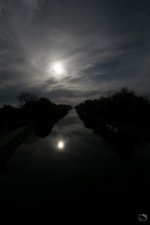
The swirls captured in this, and the colored lighting... that's pretty durn cool, man. You make me wanna go out and get some LED lighting and mess around!!
The swirls captured in this, and the colored lighting... that's pretty durn cool, man. You make me wanna go out and get some LED lighting and mess around!!
Thanks. The colored LEDs are actually white. I adjust the temperature in LR to get those effects. That and split-toning.
PatrickDeBie
Senior Member
First of all, I'm not trying to offend you 
Let's keep that clear.
I love the patterns you create with the smoke and the choice of colors is very nice. The green and red/orange ones are really nice! :encouragement:
I'm just saying that I personally think that it is better to take a good picture which can become even better with post-processing, than taking a less good one and post-process it till it becomes a good one. Especially adding blur to a picture to remove noise is something I find rather strange, because blur isn't actually meant for that. If it works, than it is OK, but you still see a lot of noise in your smoke and I find that a shame because I love the patterns you create!! Let's keep that in mind!
I'm absolutely curious about how you do that. I think you whirl the smoke source to get to this, but I'm not sure.
Finally, I'm not a pro photographer who knows every tiny detail about all the bits and pieces which comes with photography, I'm just a hobbyist and think that sometimes it's better to use the proven methods. Not that you shouldn't experiment, but in this case you can get the results you want (nice patterns and nice colors) with these proven methods.
I'll tell you what. As soon as my camera returns from the store (it's being repaired because of an auto-focus defect), I'll give smoke photography a try! Let's see what I can come up with. Not to prove that I'm better (let's not make it a competition), but to see what kind of results we can get with the use of a flash.
Let's keep that clear.
I love the patterns you create with the smoke and the choice of colors is very nice. The green and red/orange ones are really nice! :encouragement:
I'm just saying that I personally think that it is better to take a good picture which can become even better with post-processing, than taking a less good one and post-process it till it becomes a good one. Especially adding blur to a picture to remove noise is something I find rather strange, because blur isn't actually meant for that. If it works, than it is OK, but you still see a lot of noise in your smoke and I find that a shame because I love the patterns you create!! Let's keep that in mind!
I'm absolutely curious about how you do that. I think you whirl the smoke source to get to this, but I'm not sure.
Finally, I'm not a pro photographer who knows every tiny detail about all the bits and pieces which comes with photography, I'm just a hobbyist and think that sometimes it's better to use the proven methods. Not that you shouldn't experiment, but in this case you can get the results you want (nice patterns and nice colors) with these proven methods.
I'll tell you what. As soon as my camera returns from the store (it's being repaired because of an auto-focus defect), I'll give smoke photography a try! Let's see what I can come up with. Not to prove that I'm better (let's not make it a competition), but to see what kind of results we can get with the use of a flash.
I'm not easily offended. 
Maybe you're right and the "proven" method is the better one but like I said, I'm a very stubborn guy. One benefit is that I'm already learning quite a lot of what this cam can do in low light. While I never may get the smoke right like this, that knowledge is in my bag for other shots.
Maybe you're right and the "proven" method is the better one but like I said, I'm a very stubborn guy. One benefit is that I'm already learning quite a lot of what this cam can do in low light. While I never may get the smoke right like this, that knowledge is in my bag for other shots.
PatrickDeBie
Senior Member
That's a fact! :encouragement:
Just for giggles, here's a couple I shot quite a few months ago that were done in front of a dark grey background, using an on-camera SB700. I guess, after your response to my comments on your pic, there's no concerns with washing out colored LED lighting.  I'm guessing that directional lighting might also give some cool effects.
I'm guessing that directional lighting might also give some cool effects.
ISO 250, and there's still what "appears" to be noise evident in the pic. Of course, these were cropped a bit... REALLY need to get a macro lens. (well, ok, *NEED* might be over-exaggerating, but I sure would *LIKE* one! HA!)
(well, ok, *NEED* might be over-exaggerating, but I sure would *LIKE* one! HA!)


ISO 250, and there's still what "appears" to be noise evident in the pic. Of course, these were cropped a bit... REALLY need to get a macro lens.
Last edited:

